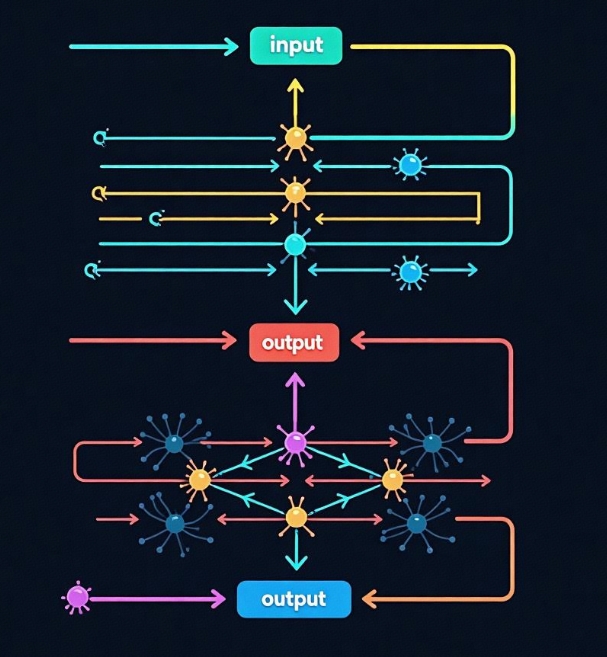The Explainability Issues of Artificial Intelligence and Their Solutions
- latest articles
- 1.DApp Development & Customization: Merging Diverse Market Needs with User Experience 2.Analysis of the Core Technical System in DApp Project Development 3.How to achieve cross-chain interoperability in Web3 projects? 4.How does the tokenization of points reconstruct the e-commerce ecosystem? 5.How to Set and Track Data Metrics for a Points Mall? 6.What is DApp Development? Core Concepts and Technical Analysis 7.Inventory of commonly used Web3 development tools and usage tips 8.Development of a Distribution System Integrated with Social E-commerce 9.Six Key Steps for Businesses to Build a Points Mall System 10.What is DApp Development? A Comprehensive Guide from Concept to Implementation
- Popular Articles
- 1.Future Trends and Technology Predictions for APP Development in 2025 2.Analysis of the DeFi Ecosystem: How Developers Can Participate in Decentralized Finance Innovation 3.From Zero to One: How PI Mall Revolutionizes the Traditional E-commerce Model 4.DAPP Development | Best Practices for Professional Customization and Rapid Launch 5.Recommended by the Web3 developer community: the most noteworthy forums and resources 6.From Cloud Computing to Computing Power Leasing: Building a Flexible and Scalable Computing Resource Platform 7.How to Develop a Successful Douyin Mini Program: Technical Architecture and Best Practices 8.Shared Bike System APP: The Convenient Choice in the Era of Smart Travel 9.How to Create a Successful Dating App: From Needs Analysis to User Experience Design 10.From Design to Development: The Complete Process of Bringing an APP Idea to Life
With the rapid development of artificial intelligence (AI) technology, its applications across various industries are becoming increasingly profound. From medical diagnosis and financial risk control to autonomous driving and speech recognition, AI is transforming human lifestyles with its powerful computational and data processing capabilities. However, alongside these significant technological breakthroughs, an important and complex issue has emerged—the problem of AI explainability.
Artificial intelligence, particularly complex models like deep learning, is often regarded as a "black box" system. Although they can achieve or even surpass human-level performance in many tasks, their decision-making processes are often opaque to users, leading to a series of issues such as lack of trust, difficulties in determining legal liability, and algorithmic bias. This article will explore the current state and challenges of AI explainability and analyze several main approaches currently being pursued to address this issue.
I. Background and Importance of AI Explainability
1.1 What is AI Explainability?
AI explainability refers to the ability of an AI system to clearly and concisely explain its decision-making process and output results to users. In traditional software development, system behavior is typically predictable and understandable, and developers can clearly know how the system makes decisions. However, in complex deep learning and machine learning models, the internal structure and parameters of the models far exceed human comprehension, making their behavior difficult to interpret and predict.
1.2 Why is Explainability So Important?
Trust and Acceptance: Users can only trust the output results of an AI system when it can clearly explain its decision logic. Especially in critical fields like healthcare and finance, AI decisions directly impact people's lives, health, and financial security. Without sufficient explainability, users may doubt AI judgments and be reluctant to rely on AI systems.
Legal and Ethical Issues: AI decisions often involve significant social responsibility. For example, if an autonomous vehicle's decision leads to a traffic accident, who should be held responsible? If an AI system cannot explain its decisions, legal accountability becomes complicated. Explainability helps clarify the chain of responsibility and protect user rights.
Algorithmic Bias: AI systems may be influenced by data bias during training, leading to unfair decisions. Explainability can help developers identify and correct these biases, ensuring the fairness and transparency of AI systems.
Debugging and Optimization: By gaining a deeper understanding of the AI model's decision-making process, developers can better debug and optimize the model, thereby improving its accuracy and efficiency.
1.3 Explainability and the Black Box Problem
Currently, deep learning models (such as Convolutional Neural Networks (CNN), Recurrent Neural Networks (RNN), etc.) have achieved breakthrough results in many tasks due to their powerful expressiveness. However, the complexity of these models makes them typical "black box" systems. Although the model outputs are usually correct, users often cannot understand how the model makes its judgments. This "black box" problem is one of the core challenges in current AI explainability research.
II. Main Challenges Facing AI Explainability
2.1 Model Complexity
Modern deep learning models typically contain millions or even billions of parameters, with diverse and complex network structures. Compared to traditional shallow models, the decision-making process of deep neural networks is filled with highly nonlinear relationships, making it difficult for humans to intuitively understand. For example, CNNs extract image features through multiple convolutional layers, while RNNs process sequential data through recursive structures over time steps. Neurons in each layer continuously change and adjust, making the final decision process very difficult to trace.
2.2 Lack of Unified Explainability Standards
Currently, there is no unified standard or evaluation system for AI explainability. Different application scenarios have different requirements for explainability. For example, in the medical field, doctors want AI to provide clear reasons to support diagnoses, while in the financial sector, regulators may be more concerned with whether AI decisions comply with relevant regulations. Therefore, how to define and evaluate the explainability of an AI model remains a question without a unified answer.
2.3 Balancing Explainability and Performance
In many cases, improving model explainability may lead to a decline in performance. Deep learning models excel in certain tasks due to their complex structures, but this complexity also makes their explainability more difficult. Many researchers face a dilemma: should they sacrifice some of the model's predictive performance to improve explainability? There is still no perfect solution to this problem.
III. Approaches to Addressing AI Explainability
3.1 Intrinsic Model Design for Explainability
One way to address the explainability issue is from the perspective of model design, constructing inherently interpretable models. In recent years, many scholars have proposed various new model architectures aimed at improving the explainability of AI systems.
Interpretable Linear Models: Traditional machine learning algorithms like linear regression and logistic regression have good explainability because their decision processes are transparent. However, these models perform far less effectively than deep learning models on complex tasks. Therefore, some researchers have proposed methods to improve these traditional models, enabling them to maintain high explainability while enhancing performance.
Interpretable Neural Networks: In recent years, some research has focused on designing neural network architectures with intrinsic interpretability. For example, methods like Explainable Convolutional Neural Networks (Explainable CNN) and Explainable Graph Neural Networks (Explainable GNN) aim to provide more transparent decision processes through layer visualization or reconstruction of input features.
3.2 Post-hoc Explainability Methods
For complex black-box models, post-hoc methods refer to techniques applied after the model is trained to enhance its explainability. These methods mainly include:
LIME (Local Interpretable Model-agnostic Explanations): LIME is a model-agnostic local interpretability method. It generates simple, understandable models by linearly approximating local regions of the complex model, thereby explaining the complex model's decisions on specific data points.
SHAP (SHapley Additive exPlanations): SHAP is an explainability method based on game theory. It provides explanations by calculating the contribution of each feature to the model's prediction results. The core idea of SHAP is to quantify each feature's contribution by calculating Shapley values, thereby offering fair and consistent explanations.
Visualization Techniques: In recent years, using visualization techniques to help understand the internal decision-making processes of deep learning models has become a mainstream method. For example, visualizing the intermediate layer outputs of neural networks can help us understand how the network processes input data. Methods like Class Activation Mapping (CAM) and Grad-CAM reveal the key regions the model focuses on by visualizing activation areas in convolutional neural networks, providing intuitive understanding of the decision process.
3.3 Data Enhancement and Explainability Evaluation
In addition to model optimization itself, data is also a key factor affecting AI explainability. Enhancing and optimizing training data can improve model explainability in specific scenarios. For example, data augmentation techniques, by generating more diverse training samples, can help the model better understand the importance of specific features. Furthermore, evaluation methods for model explainability are continuously being refined to scientifically quantify the explainability of different models.
3.4 Establishment of Legal and Ethical Frameworks
Solving the AI explainability problem does not rely solely on technological progress; it also requires the support of corresponding legal and ethical frameworks. With the proliferation of AI technology, governments and regulatory agencies worldwide are gradually introducing policies requiring AI systems in certain fields to possess sufficient explainability. For instance, the European Union, in its "Artificial Intelligence Act," has proposed explainability requirements for high-risk AI systems, stipulating that the decision-making processes of these systems must be transparent to allow for review and supervision.
IV. Conclusion
The explainability of artificial intelligence is a major challenge in the current application of AI technology, directly related to its trustworthiness, legality, and social acceptability. Although there is a certain contradiction between explainability and performance, with technological advancement, more and more solutions are gradually emerging. From intrinsic model design to post-hoc explainability methods, and the establishment of legal and ethical frameworks, various forces are actively promoting the resolution of this issue. In the future, as AI technology continues to mature and explainability research deepens, artificial intelligence is expected to truly move towards a transparent, trustworthy, and controllable future.
-

How does artificial intelligence technology transform the operational models of modern enterprises?
In the wave of the digital era, artificial intelligence (AI) technology has tran···
-

How to Utilize Artificial Intelligence for Precision Medicine and Health Management
With the rapid advancement of technology, artificial intelligence (AI) has demon···
-

Integration and Application of Artificial Intelligence and Robotics
In today's era of rapid technological advancement, the integration of artificial···

 Blockchain
Blockchain












